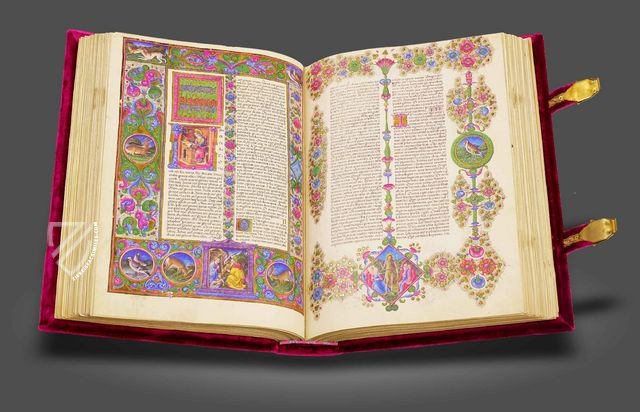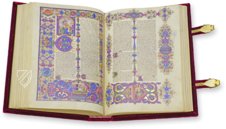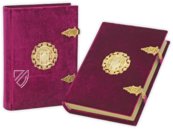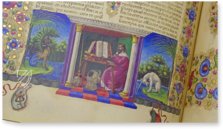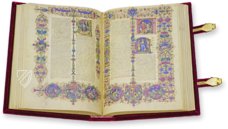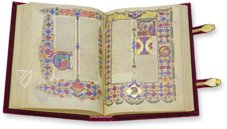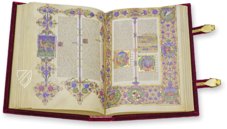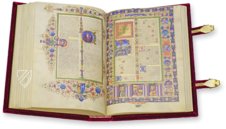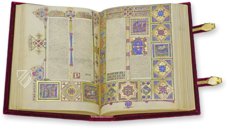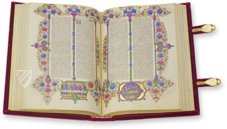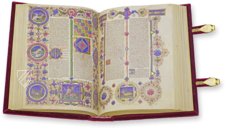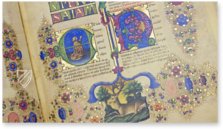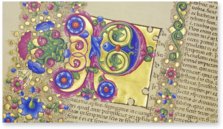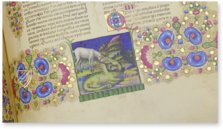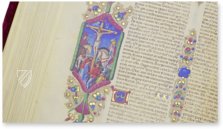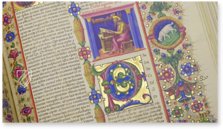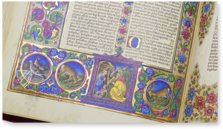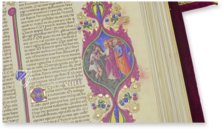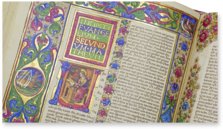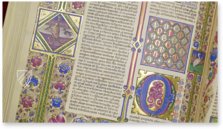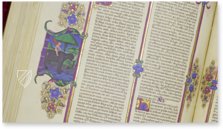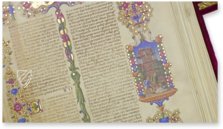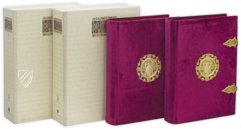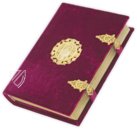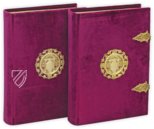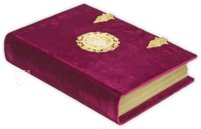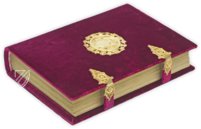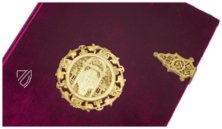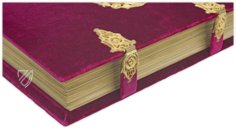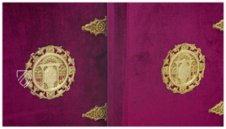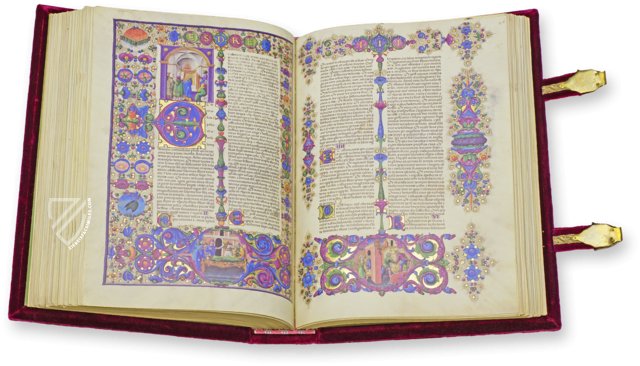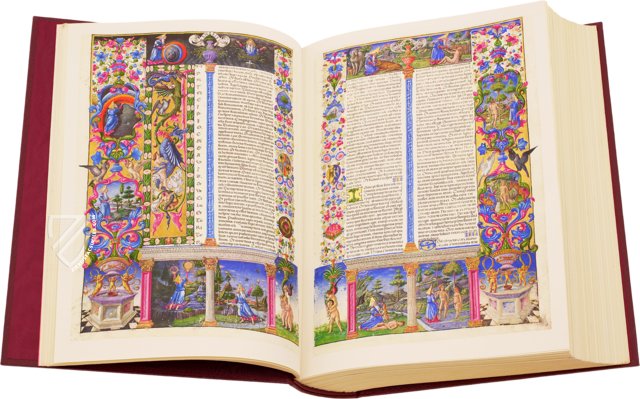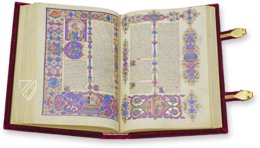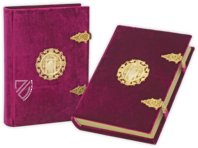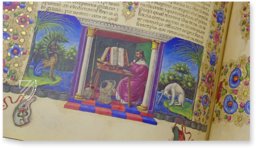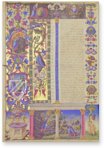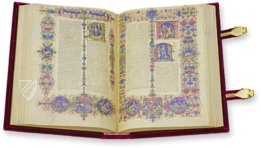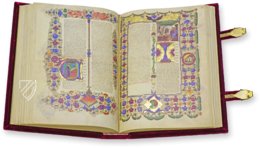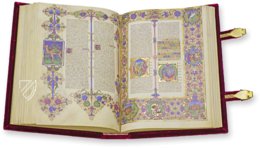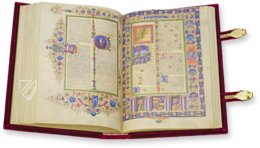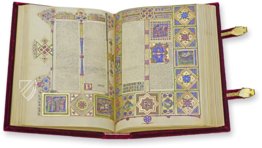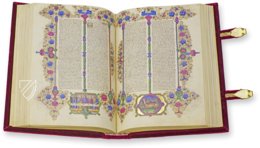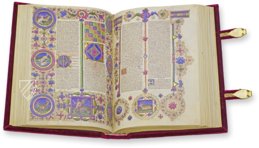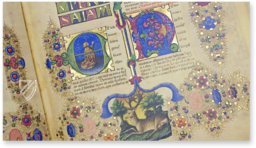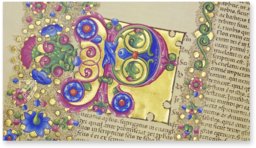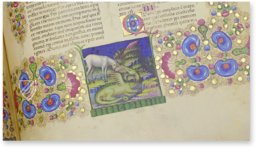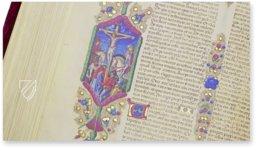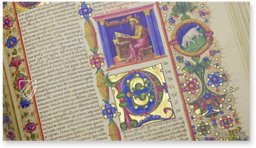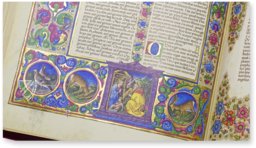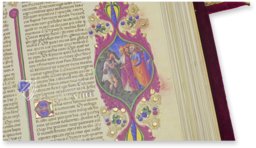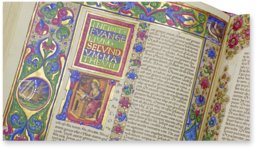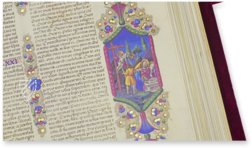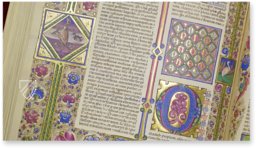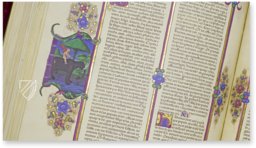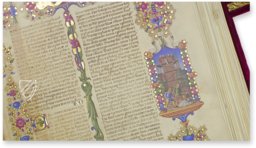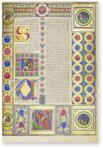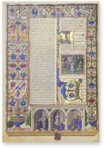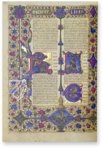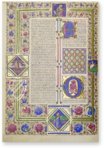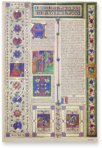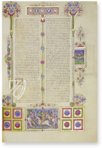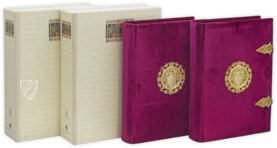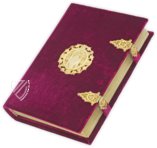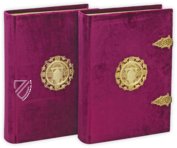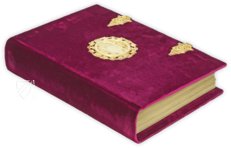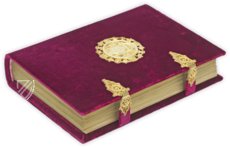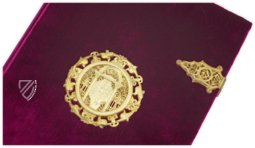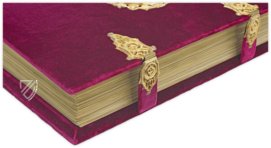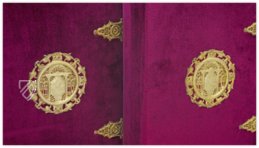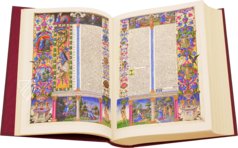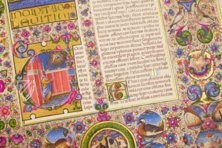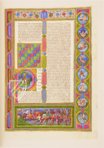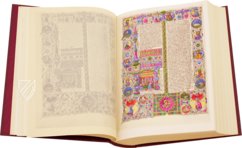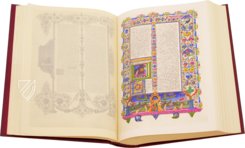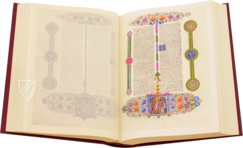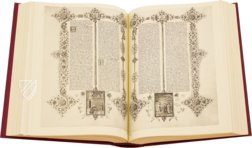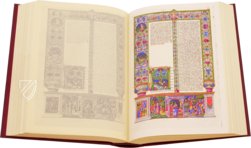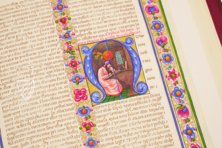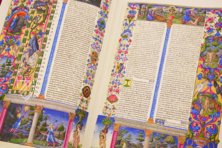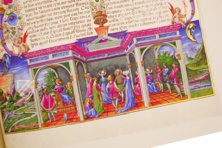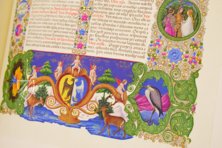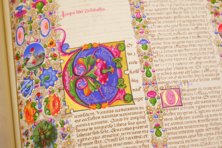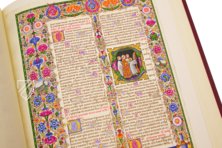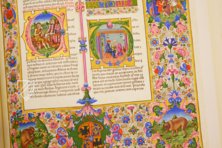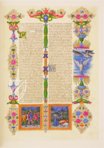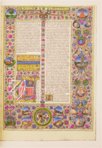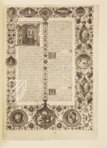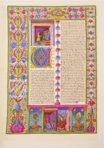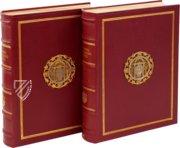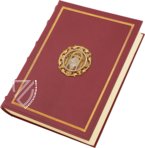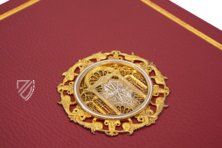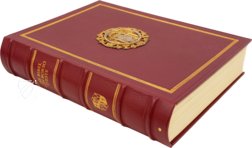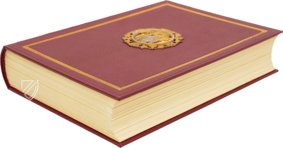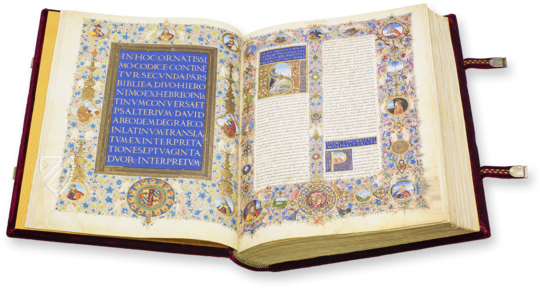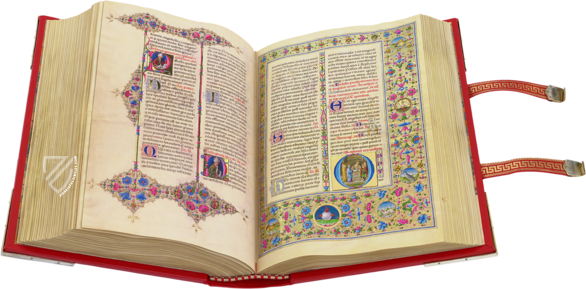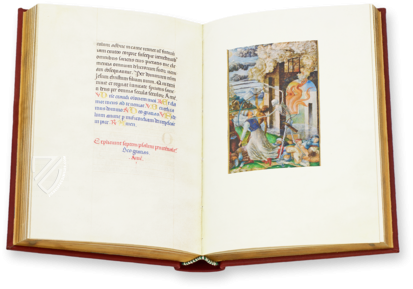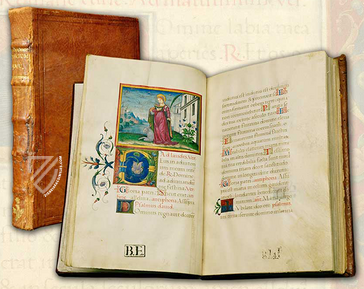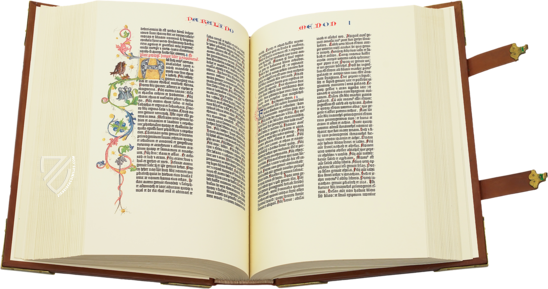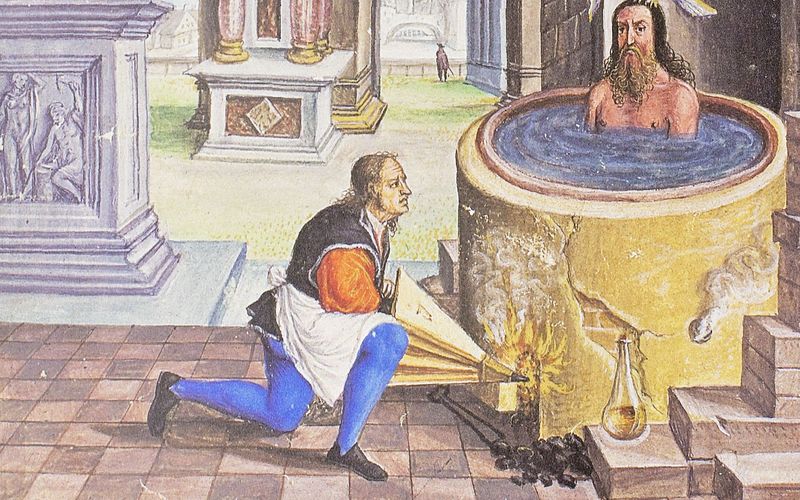Bible of Borso d'Este
(over 10,000€)
The Bible of Borso d’Este was made between 1455 and 1461 by the most gifted Renaissance artists of Italy at the court of the Count of Este in Ferrara. It represents a highpoint of Italian illumination and combines the realistic painting of the Renaissance with fanciful Gothic stylistic elements in a unique way. Each page of the manuscript is illuminated with impressive diversity.
Bible of Borso d'Este
Italy was a stronghold of art and science during the time period of the Renaissance. The innovative painting, architecture, sculpture, as well as the literature and philosophy of Italy influenced artists and scholars from all lands. The whole world oriented itself on the culture of Italy. An artistic center of Italy found itself at the court of Margrave Borso d’Este von Modena, Ferrara, and Reggio. In the Ferrara painting school, some of the most talented painters and illustrators of the Renaissance learned their craft. Numerous impressive illuminated manuscripts originated from here. Among them is numbered the breathtaking *Bible of Borso d’Este. The two-part work, encompassing over 1,200 pages, is adorned with delightful miniatures and marginal depictions on each page.
The Book Craft of the Renaissance
Margrave Borso d’Este was a well-read and highly-educated man. He remained unmarried and had no heirs. His life was his duchy, which was dedicated to art and religion. The count commissioned numerous Latin and Greek manuscripts, which were made by famous book artists such as Taddeo Crivelli, Franco dei Russi, Guglielmo Giraldi, and Girolamo de’ Corradi. These very same four outstanding artists, as well as additional staff from their art studios, produced the two-volume bible for the count. The miniaturists painted each sheet of the book double-sided and oriented themselves on the new rules of perspective from Tuscany and on the realism of Flemish art.
An Inconceivable Variety of Design
The hand-written text of the Renaissance bible is decorated with countless initials and embellished letters in luminous colors and with shimmering applications of gold leaf. Numerous full-page miniatures of surprising realism visualize the events reflected in the text and enthrall every beholder. Especially noteworthy are the marginal embellishments of each page, which show an unbelievable variety of motifs from mythology, the animal kingdom, and heraldry. In this codex, the masterful illuminators managed to merge the new visual language of the Renaissance with the fantasy and elegance of the late Gothic. The bible represents the absolute highpoint of Italian Renaissance illumination.
The History of the Codex
As an overall work, the Bible of Borso d’Este represents an exceptional gallery of Renaissance painting, whose splendor was reached by no other contemporary monument. During the confusion of the First World War, the famous and globally sought-after masterpiece came into the possession of the last Austrian Empress Zita von Hapsburg, who wanted to sell it in America. Through the great Italian industrialist Giovanni Treccani, the document was able to be acquired for Italy through a sacrificial action. Today the splendid codex is found in the Bibilioteca Estense Universitaria in Modena.
Codicology
- Alternative Titles
- Bibbia di Borso d'Este
Bibel des Borso d’Este - Size / Format
- 2 volumes - 1,208 pages / 37.5 × 26.5 cm
- Origin
- Italy
- Date
- 1455–1461
- Epochs
- Style
- Genre
- Language
- Script
- Italian gothic script
- Illustrations
- Numerous scenic miniatures, historiated initials, border friezes, architectural border motifs, heraldic rectangular fields and medallions
- Patron
- Borso d'Este (1413–1471), Duke of Modena and Reggio Emilia
- Artist / School
- Taddeo Crivelli (1425 – before 1479)
Franco de Rossi
Giorgio D'Alemagna
Marco di Giovanni dell'Avogaro
Girolamo da Cremona and others - Previous Owners
- Senator Giovanni Traccani
Bible of Borso d'Este
Predator and Prey
By the 15th century, Italian illuminators left virtually no blank space on the page, and Renaissance art provided countless motifs to fill the marginalia. Graphic scenes of the harsh realities of natures are presented in this pair of bas-de-page miniatures with magnificently patterned frames of gold leaf, red, and blue. On the left we see a bird of prey attacking a crane and digging in with its claws while a white greyhound savagely seizes a rabbit by the throat on the right.
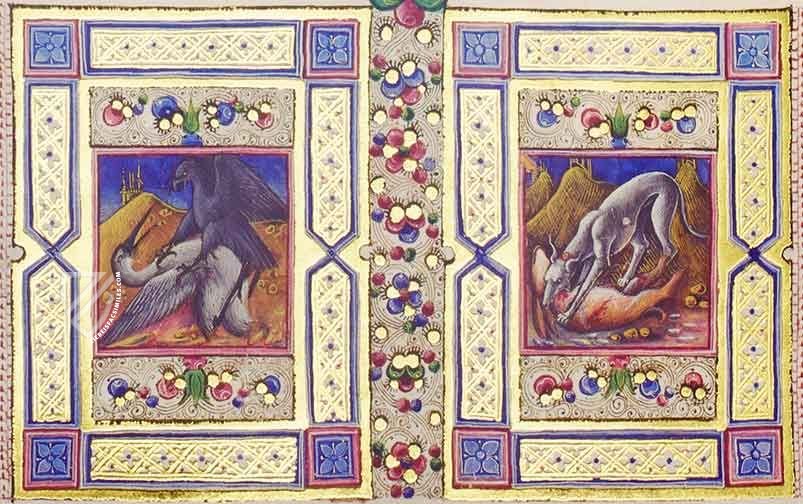
Bible of Borso d'Este
Scenes from Creation
This magnificent page from the Book of Genesis is just a sample of this highpoint of Italian Renaissance Illumination. Each of the two-volume work’s 1,200 pages is adorned with a fantastic color palette, gold leaf, and countless details that populate the page.
The tremendous talent of the artists led by Taddeo Crivelli and Franco dei Russ allows for the harmonious presentation of an otherwise overwhelming cacophony of illumination on this page, which covers Genesis 1:1–20 in six miniatures in the margins. The Creator is depicted throughout with a triangular halo, a late-medieval invention signifying the Trinity and only used with God the Father. These are accompanied by floral designs, animals, grotesques, and architectures of the highest caliber.
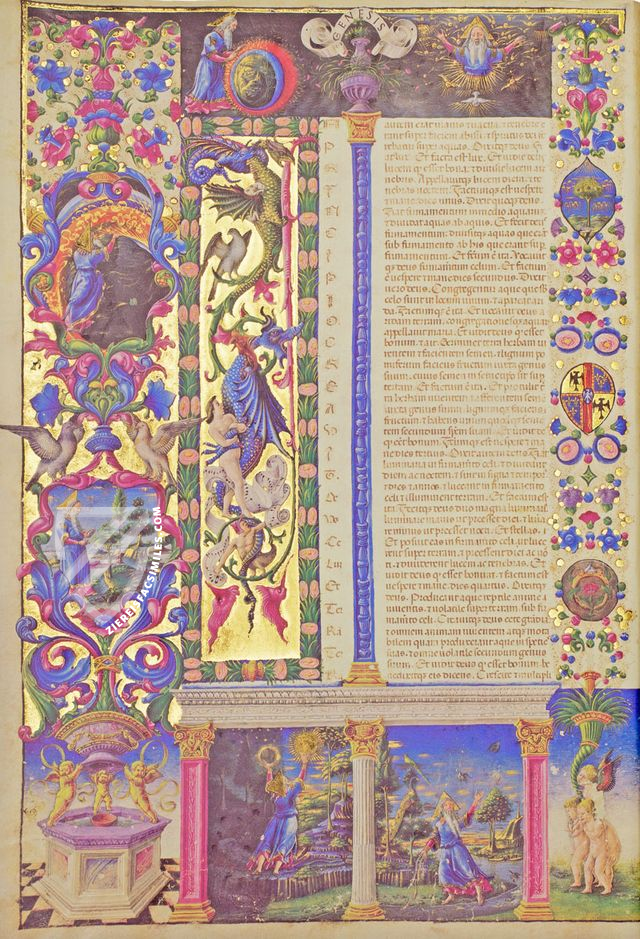
#1 Bibbia di Borso d'Este
Language: Italian
(over 10,000€)
#2 Die Bibel des Borso d'Este
(1,000€ - 3,000€)
- Treatises / Secular Books
- Apocalypses / Beatus
- Astronomy / Astrology
- Bestiaries
- Bibles / Gospels
- Chronicles / History / Law
- Geography / Maps
- Saints' Lives
- Islam / Oriental
- Judaism / Hebrew
- Single Leaf Collections
- Leonardo da Vinci
- Literature / Poetry
- Liturgical Manuscripts
- Medicine / Botany / Alchemy
- Music
- Mythology / Prophecies
- Psalters
- Other Religious Books
- Games / Hunting
- Private Devotion Books
- Other Genres
- Afghanistan
- Armenia
- Austria
- Belgium
- Belize
- Bosnia and Herzegovina
- China
- Colombia
- Costa Rica
- Croatia
- Cyprus
- Czech Republic
- Denmark
- Egypt
- El Salvador
- Ethiopia
- France
- Germany
- Greece
- Guatemala
- Honduras
- Hungary
- India
- Iran
- Iraq
- Israel
- Italy
- Japan
- Jordan
- Kazakhstan
- Kyrgyzstan
- Lebanon
- Liechtenstein
- Luxembourg
- Mexico
- Morocco
- Netherlands
- Palestine
- Panama
- Peru
- Poland
- Portugal
- Romania
- Russia
- Serbia
- Spain
- Sri Lanka
- Sweden
- Switzerland
- Syria
- Tajikistan
- Turkey
- Turkmenistan
- Ukraine
- United Kingdom
- United States
- Uzbekistan
- Vatican City
- A. Oosthoek, van Holkema & Warendorf
- Aboca Museum
- Ajuntament de Valencia
- Akademie Verlag
- Akademische Druck- u. Verlagsanstalt (ADEVA)
- Aldo Ausilio Editore - Bottega d’Erasmo
- Alecto Historical Editions
- Alkuin Verlag
- Almqvist & Wiksell
- Amilcare Pizzi
- Andreas & Andreas Verlagsbuchhandlung
- Archa 90
- Archiv Verlag
- Archivi Edizioni
- Arnold Verlag
- ARS
- Ars Magna
- ArtCodex
- AyN Ediciones
- Azimuth Editions
- Badenia Verlag
- Bärenreiter-Verlag
- Belser Verlag
- Belser Verlag / WK Wertkontor
- Benziger Verlag
- Bernardinum Wydawnictwo
- BiblioGemma
- Biblioteca Apostolica Vaticana (Vaticanstadt, Vaticanstadt)
- Bibliotheca Palatina Faksimile Verlag
- Bibliotheca Rara
- Boydell & Brewer
- Bramante Edizioni
- Bredius Genootschap
- Brepols Publishers
- British Library
- C. Weckesser
- Caixa Catalunya
- Canesi
- CAPSA, Ars Scriptoria
- Caratzas Brothers, Publishers
- Carus Verlag
- Casamassima Libri
- Centrum Cartographie Verlag GmbH
- Chavane Verlag
- Christian Brandstätter Verlag
- Circulo Cientifico
- Club Bibliófilo Versol
- Club du Livre
- CM Editores
- Collegium Graphicum
- Collezione Apocrifa Da Vinci
- Comissão Nacional para as Comemorações dos Descobrimentos Portugueses
- Coron Verlag
- Corvina
- CTHS
- D. S. Brewer
- Damon
- De Agostini/UTET
- De Nederlandsche Boekhandel
- De Schutter
- Deuschle & Stemmle
- Deutscher Verlag für Kunstwissenschaft
- DIAMM
- Droz
- E. Schreiber Graphische Kunstanstalten
- Ediciones Boreal
- Ediciones Grial
- Ediclube
- Edições Inapa
- Edilan
- Editalia
- Edition Deuschle
- Edition Georg Popp
- Edition Leipzig
- Edition Libri Illustri
- Editiones Reales Sitios S. L.
- Éditions de l'Oiseau Lyre
- Editions Medicina Rara
- Editorial Casariego
- Editorial Mintzoa
- Editrice Antenore
- Editrice Velar
- Edizioni Edison
- Egeria, S.L.
- Eikon Editores
- Electa
- Emery Walker Limited
- Enciclopèdia Catalana
- Eos-Verlag
- Ephesus Publishing
- Ernst Battenberg
- Eugrammia Press
- Extraordinary Editions
- Fackelverlag
- Facsimila Art & Edition
- Facsimile Editions Ltd.
- Facsimilia Art & Edition Ebert KG
- Faksimile Verlag
- Feuermann Verlag
- Folger Shakespeare Library
- Franco Cosimo Panini Editore
- Friedrich Wittig Verlag
- Fundación Hullera Vasco-Leonesa
- G. Braziller
- Gabriele Mazzotta Editore
- Gebr. Mann Verlag
- Gesellschaft für graphische Industrie
- Getty Research Institute
- Giovanni Domenico de Rossi
- Giunti Editore
- Graffiti
- Grafica European Center of Fine Arts
- Guido Pressler
- Guillermo Blazquez
- Gustav Kiepenheuer
- H. N. Abrams
- Harrassowitz
- Harvard University Press
- Helikon
- Hendrickson Publishers
- Henning Oppermann
- Herder Verlag
- Hes & De Graaf Publishers
- Hoepli
- Holbein-Verlag
- Houghton Library
- Hugo Schmidt Verlag
- Idion Verlag
- Il Bulino, edizioni d'arte
- ILte
- Imago
- Insel Verlag
- Insel-Verlag Anton Kippenberger
- Instituto de Estudios Altoaragoneses
- Instituto Nacional de Antropología e Historia
- Introligatornia Budnik Jerzy
- Istituto dell'Enciclopedia Italiana - Treccani
- Istituto Ellenico di Studi Bizantini e Postbizantini
- Istituto Geografico De Agostini
- Istituto Poligrafico e Zecca dello Stato
- Italarte Art Establishments
- Jan Thorbecke Verlag
- Johnson Reprint Corporation
- Josef Stocker
- Josef Stocker-Schmid
- Jugoslavija
- Karl W. Hiersemann
- Kasper Straube
- Kaydeda Ediciones
- Kindler Verlag / Coron Verlag
- Kodansha International Ltd.
- Konrad Kölbl Verlag
- Kurt Wolff Verlag
- La Liberia dello Stato
- La Linea Editrice
- La Meta Editore
- Lambert Schneider
- Landeskreditbank Baden-Württemberg
- Leo S. Olschki
- Les Incunables
- Liber Artis
- Library of Congress
- Libreria Musicale Italiana
- Lichtdruck
- Lito Immagine Editore
- Lumen Artis
- Lund Humphries
- M. Moleiro Editor
- Maison des Sciences de l'homme et de la société de Poitiers
- Manuscriptum
- Martinus Nijhoff
- Maruzen-Yushodo Co. Ltd.
- MASA
- Massada Publishers
- McGraw-Hill
- Metropolitan Museum of Art
- Militos
- Millennium Liber
- Müller & Schindler
- Nahar - Stavit
- Nahar and Steimatzky
- National Library of Wales
- Neri Pozza
- Nova Charta
- Oceanum Verlag
- Odeon
- Orbis Mediaevalis
- Orbis Pictus
- Österreichische Staatsdruckerei
- Oxford University Press
- Pageant Books
- Parzellers Buchverlag
- Patrimonio Ediciones
- Pattloch Verlag
- PIAF
- Pieper Verlag
- Plon-Nourrit et cie
- Poligrafiche Bolis
- Presses Universitaires de Strasbourg
- Prestel Verlag
- Princeton University Press
- Prisma Verlag
- Priuli & Verlucca, editori
- Pro Sport Verlag
- Propyläen Verlag
- Pytheas Books
- Quaternio Verlag Luzern
- Reales Sitios
- Recht-Verlag
- Reichert Verlag
- Reichsdruckerei
- Reprint Verlag
- Riehn & Reusch
- Roberto Vattori Editore
- Rosenkilde and Bagger
- Roxburghe Club
- Salerno Editrice
- Saltellus Press
- Sandoz
- Sarajevo Svjetlost
- Schöck ArtPrint Kft.
- Schulsinger Brothers
- Scolar Press
- Scrinium
- Scripta Maneant
- Scriptorium
- Shazar
- Siloé, arte y bibliofilia
- SISMEL - Edizioni del Galluzzo
- Sociedad Mexicana de Antropología
- Société des Bibliophiles & Iconophiles de Belgique
- Soncin Publishing
- Sorli Ediciones
- Stainer and Bell
- Studer
- Styria Verlag
- Sumptibus Pragopress
- Szegedi Tudomànyegyetem
- Taberna Libraria
- Tarshish Books
- Taschen
- Tempus Libri
- Testimonio Compañía Editorial
- Thames and Hudson
- The Clear Vue Publishing Partnership Limited
- The Facsimile Codex
- The Folio Society
- The Marquess of Normanby
- The Richard III and Yorkist History Trust
- Tip.Le.Co
- TouchArt
- TREC Publishing House
- TRI Publishing Co.
- Trident Editore
- Tuliba Collection
- Typis Regiae Officinae Polygraphicae
- Union Verlag Berlin
- Universidad de Granada
- University of California Press
- University of Chicago Press
- Urs Graf
- Vallecchi
- Van Wijnen
- VCH, Acta Humaniora
- VDI Verlag
- VEB Deutscher Verlag für Musik
- Verlag Anton Pustet / Andreas Verlag
- Verlag Bibliophile Drucke Josef Stocker
- Verlag der Münchner Drucke
- Verlag für Regionalgeschichte
- Verlag Styria
- Vicent Garcia Editores
- W. Turnowski Ltd.
- W. Turnowsky
- Waanders Printers
- Wiener Mechitharisten-Congregation (Wien, Österreich)
- Wissenschaftliche Buchgesellschaft
- Wissenschaftliche Verlagsgesellschaft
- Wydawnictwo Dolnoslaskie
- Xuntanza Editorial
- Zakład Narodowy
- Zollikofer AG

